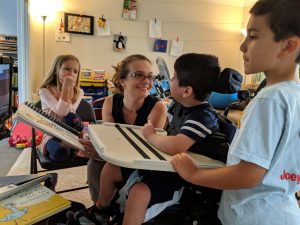 As we prepared Joey for school, I noticed a dip in his AAC output data. There were many reasons for this, and a main one was that Joey is becoming stronger at navigating his device. Although he still may select the wrong icon, he is able to navigate himself back to the right page faster. He selects fewer wrong pictures, which leads to a decrease in total output, but an increase in meaningful output.
As we prepared Joey for school, I noticed a dip in his AAC output data. There were many reasons for this, and a main one was that Joey is becoming stronger at navigating his device. Although he still may select the wrong icon, he is able to navigate himself back to the right page faster. He selects fewer wrong pictures, which leads to a decrease in total output, but an increase in meaningful output.
Yet as I look over our back and forth communication over the last month, I suspect there is another reason the output decreased. Early on in August, we introduced a social story to Joey about being quiet in school – and how sometimes he will need to be quiet, and sometimes he will be able to talk. Read alouds were a time when he would need to be quiet, and share his thoughts and ideas when a teacher asked him to.
His decrease in verbal output occurred around the same time that we introduced this book, and I realized that Joey pretty quickly applied the lessons of that social story into our daily work. The purpose behind his communication with me transitioned from frequently talking, sharing what he noticed, his thoughts, or his off-topic responses, to being completely on-topic, and only responding to my direct questions. The majority of the purposes behind his communication now come from responding to a question, making a demand, or selecting the wrong icon. Before, most of his purposes were from making observations and sharing them with us.
There are positive and negatives to this change. It shows pretty significant growth that Joey was able to respond quickly to a social story, and that he shows the executive functioning control to stay on topic, and answer questions when asked. These are important skills, especially for a school setting.
The negative drawback is in my court as a teacher. Am I giving him enough spontaneous time to just talk? If he is leaning towards only responding to my questions, am I varying my questions enough so that they are open-ended and are encouraging higher level thinking? Am I giving Joey time to share his thoughts and feelings about his day, and am I communicating that I want to hear his thoughts? It would be detrimental to his communication development if I sent the message that he should only talk when prompted.
On Friday, after we finished up a book, I asked Joey which book he wanted to read next. “Talk” he said. So we did. And in the ten minute data window, Joey made 62 hits on his AAC device – all of which were independent, and done without my prompting. His average output in a ten minute session is usually around 23 hits. We chatted about making words plural, and made silly words by adding lots of plurals to a word. He asked me how many pterodactyl would be if we had “pterodactyleseseseses” and I tried to explain how grammar works. We talked about giants, monsters, and lobsters, trucks and helicopters. Sometimes it was unclear to me what our topic was, but I tried to presume competence and kept responding to his shared thoughts and ideas. As our talking time went along, his verbal output increased as well. Although I couldn’t determine everything he was saying, he had a lot to share both verbally and on his device, and kept checking in with me through his eye gaze to let me know this was all part of the story.
It was a wonderful reminder for me that Joey needs a balance of direct, top-down instruction, as well as just open time to talk, explore, and to go off on tangents.


